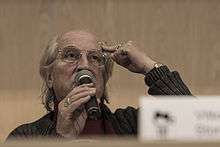Vittorio Storaro

Vittorio Storaro, A.S.C., A.I.C. (born 24 June 1940) is an Italian cinematographer. In 2003, a survey conducted by the International Cinematographers Guild judged Storaro one of history's ten most influential cinematographers.[1]
Life and career

Storaro was born in Rome. The son of a film projectionist, Storaro began studying photography at the age of 11. He went on to formal cinematography studies at the national Italian film school, Centro Sperimentale di Cinematografia, when he was 18. Working as a camera operator for many years, he was on his first film as cinematographer for Giovinezza, Giovinezza (Youthful, Youthful) in 1968. In 1970, he photographed L'uccello dalle piume di cristallo (The Bird with the Crystal Plumage), the first film directed by Dario Argento.
He has worked with many important film directors, in particular Bernardo Bertolucci, with whom he has had a long collaboration,[2] as well as Francis Ford Coppola, Carlos Saura and Warren Beatty.
His credits include 1900, The Conformist, Last Tango in Paris, The Last Emperor, Dominion: Prequel to the Exorcist, Apocalypse Now, One From the Heart, Reds, Dick Tracy, Bulworth, The Sheltering Sky, Tucker: The Man and His Dream, Ladyhawke, Tango and Goya en Burdeos. He was also cinematographer for a BBC co-production with Italian broadcaster RAI of Verdi's Rigoletto over two nights on the weekend of 4 and 5 September 2010.
Storaro’s first mainstream American film was Apocalypse Now, directed by Francis Ford Coppola in 1979, for which Storaro won his first Oscar. Coppola gave Storaro free rein on the film's visual look and it is regarded by many critics as one of the most visually spectacular films of all time.[3] He has also received Oscars for Reds (1981) and The Last Emperor (1987). Dick Tracy (1990) garnered him a fourth nomination.
Storaro is widely regarded as a master cinematographer with a sophisticated philosophy largely inspired by Johann Wolfgang von Goethe's theory of colors, which focuses in part on the psychological effects that different colors have and the way in which colors influence our perceptions of different situations. With his son, Fabrizio Storaro, he created the Univisium format system to unify all future theatrical and television movies into one respective aspect ratio of 2.00:1. In 2002, Storaro completed the first in a series of books that attempt to articulate his philosophy of cinematography more substantively.
Storaro is known for stylish, fastidious, and flamboyant personal fashion. Francis Ford Coppola once noted that Storaro was the only man he ever knew that could fall off a ladder in a white suit, into the mud, and not get dirty.
Filmography
References
- ↑ "Top 10 Most Influential Cinematographers Voted on by Camera Guild". October 16, 2013. Retrieved 8 July 2014.
- ↑ According to critic Leonard Maltin, Bertolucci's 1970 movie "The Spider's Stratagem ... boasts some of the most beautiful color cinematography (by Vittorio Storaro) in memory." "Leonard Maltin's 1997 Movie & Video Guide", (New York: Penguin Books, 1996 ISBN 0-451-18888-8), p. 1252.
- ↑ "Apocalypse Now (1979) C-150m. ***1/2 ... with staggering, Oscar-winning photography by Vittorio Storaro," "Leonard Maltin's 1997 Movie & Video Guide," (New York: Penguin Books, 1996 ISBN 0-451-18888-8), p. 53.
- Masters of Light - Conversations with cinematographers (1984) Schaefer, S & Salvato, L., ISBN 0-520-05336-2
- Vittorio Storaro: Writing with Light: Volume 1: The Light (2002) Storaro, V., ISBN 1-931788-03-0
- Writer of Light: The Cinematography of Vittorio Storaro, ASC, AIC (2000) Zone, R., ISBN 0-935578-18-8
External links
| Wikimedia Commons has media related to Vittorio Storaro. |
- Vittorio Storaro at the Internet Movie Database
- International Cinematographers Guild Interview
- Vittorio Storaro Website (Italian or English)